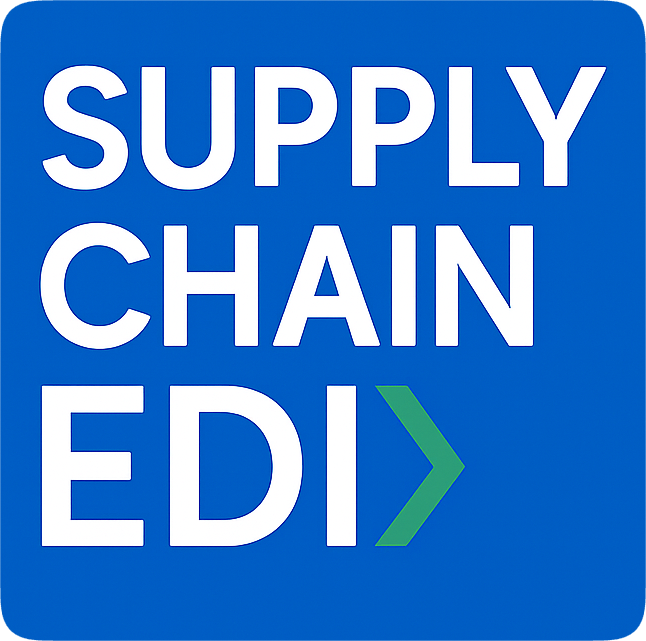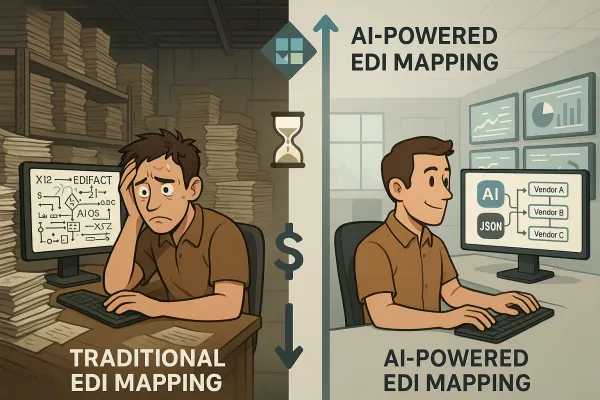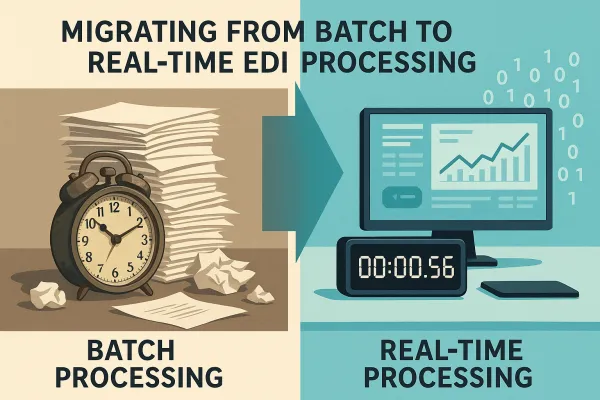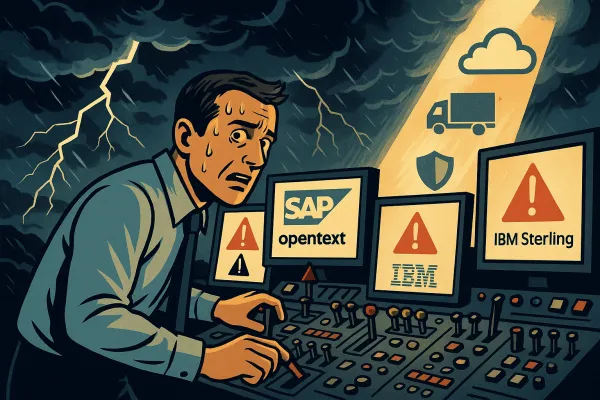The Complete EDI Partner Onboarding Automation Framework: How to Cut Setup Time from 6 Weeks to 5 Days Using AI-Powered Validation and Pre-Built Templates in 2025
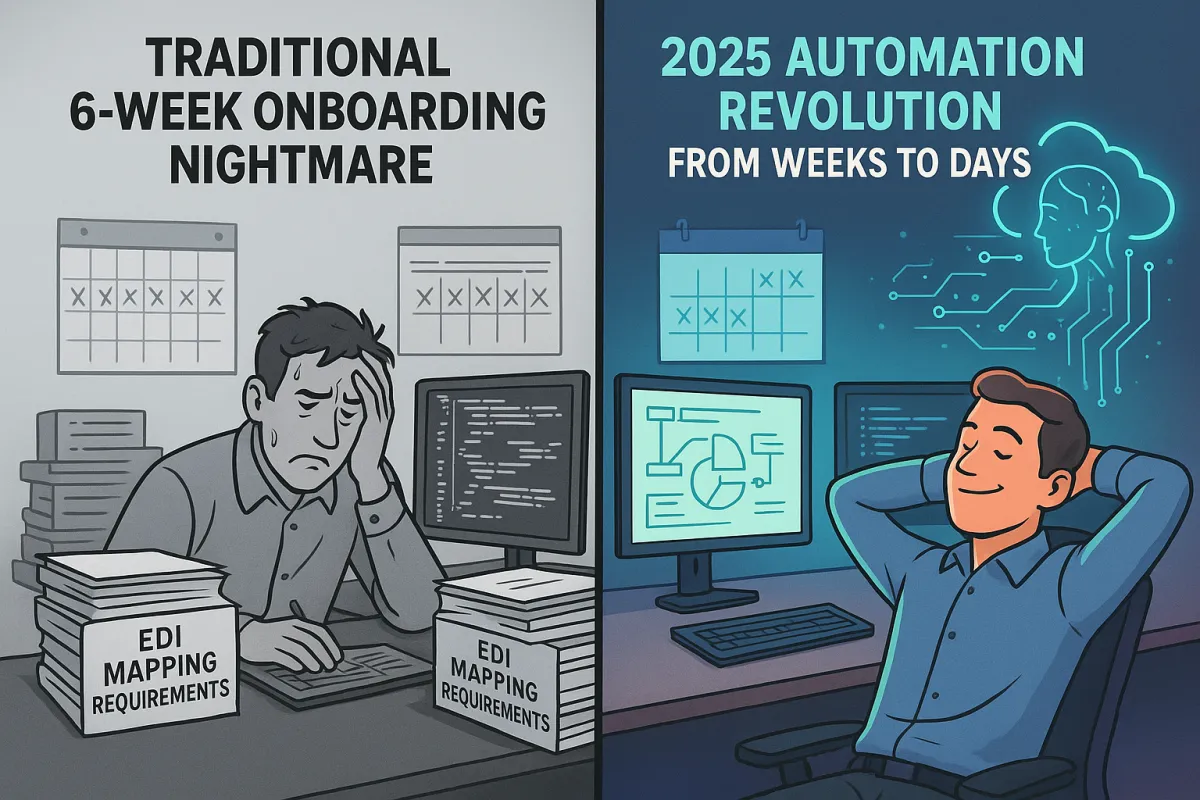
Your EDI partner onboarding automation system should cut setup time from weeks to days, not months to years. Despite decades of promises, 53% of enterprises experience limitations with their current B2B integration solutions when onboarding trading partners, and approximately 40% of enterprises require over 30 days to onboard a new trading partner. The real frustration? Nearly two-thirds (63%) of IT decision-makers say that the EDI onboarding process takes too long because of customized requirements demanded by trading partners, with 47% of IT managers reporting that slow EDI supplier onboarding is keeping their businesses from capturing new revenue opportunities.
The math is simple: every week spent onboarding a new supplier equals lost revenue and frustrated partners. Nearly a quarter of companies (24%) are losing $500K or more to integration issues related to their supply chains. But 2025 brings real solutions that eliminate these bottlenecks through AI-powered automation frameworks that transform onboarding from a 6-week nightmare into a 5-day process.
The Traditional 6-Week Onboarding Nightmare
Most EDI teams know the drill by heart. New partner requests arrive with custom specifications that demand unique mapping configurations. Each partner you work with will have unique requirements - one partner might send you an 850 purchase order that contains an SDQ segment identifying which locations to ship the order to, while another partner might send one 850 purchase order for each shipment location.
Take automotive manufacturing. A single supplier might need 47 different mapping variations for standard 850 purchase orders, depending on whether they're shipping to assembly plants, distribution centers, or service locations. Each variation requires manual configuration, testing cycles, and validation rounds. EDI onboarding is driven by humans, which includes back and forth feedback loops that aren't in real time, resulting in wasted time and delays.
The testing phase alone becomes a coordination nightmare. EDI testing requires both partners to work on the same time frame, often turning what should be simple validation into weeks of schedule coordination. By the time you reach go-live, both parties are exhausted, deadlines are missed, and the business relationship suffers before it even begins.
The 2025 Automation Revolution: From Weeks to Days
AI-powered EDI platforms are changing how partner onboarding works at a fundamental level. AI uses machine learning to recognize patterns in data structures, reducing onboarding time, and minimizing errors. Instead of starting from scratch with each new partner, intelligent systems learn from historical mappings and automatically suggest configurations for similar document types.
One of the most time-consuming aspects of EDI has always been data mapping. AI is now accelerating this process by learning from semantic models and automating field matching, reducing setup time and simplifying updates over time. Modern platforms like Cleo's Integration Cloud are 10x faster onboarding into the Cleo Network of retailers, shippers, suppliers, marketplaces, logistics providers, and distributors.
The competitive landscape now includes established players like TrueCommerce and IBM Sterling alongside newer entrants. Cargoson offers cloud-based automation tools that complement these traditional providers, while EDI Partners guarantees onboarding new trading partners in a few business days, backed by structured and automated mapping and testing.
Boomi automates onboarding by configuring trading partner profiles, validating compliance requirements, and streamlining document exchanges, reducing setup time from weeks to minutes. This isn't theoretical anymore – companies are seeing real results with production implementations.
The 5-Step Automated Onboarding Framework
Successful automated onboarding follows a structured approach that eliminates traditional bottlenecks while maintaining compliance standards.
Step 1: Automated partner discovery and capability assessment
AI systems scan partner documentation and automatically extract requirements from trading partner guidelines. Pre-built EDI and API integrations automate transactions directly into your back-office systems (ERP, TMS, WMS, shipping software, and more). The system identifies document types, communication protocols, and business rules without manual analysis.
Step 2: Pre-built templates and validation processes
Modern platforms maintain libraries of industry-specific templates that cover common scenarios. Automation tools with pre-built templates and validation processes ensure that new partners can integrate and start transacting swiftly, minimizing delays and errors. These templates include compliance validation for different standards and automatically adjust for partner-specific requirements.
Step 3: AI-powered mapping and translation setup
Boomi eliminates the complexity of data transformations by automatically mapping fields between different document formats. This reduces manual effort, ensures consistency, and accelerates data exchange. The system learns from successful mappings across similar partners and applies those patterns to new integrations.
Step 4: Automated testing and validation cycles
Cleo automates supplier testing and certification, validating partner documents and managing the full testing workflow to ensure compliance before go-live. Real-time validation catches errors before they disrupt operations, eliminating the traditional back-and-forth testing cycles.
Step 5: Real-time monitoring and error resolution
AI-driven EDI solutions instantly identify and correct partner errors in real time, preventing costly order delays and revenue loss, while AI surfaces errors and recommended resolution paths - reducing the time to identify, investigate, and resolve issues.
Essential Pre-Built Templates and Validation Rules
Your automation framework needs comprehensive coverage of common EDI document types. Focus on building templates for the core transaction sets: 850 (Purchase Orders), 855 (Purchase Order Acknowledgment), 856 (Advance Ship Notice), 810 (Invoice), and 997 (Functional Acknowledgment).
Industry-specific templates prove especially valuable. Retail partners often require unique pricing structures and promotional handling in their 850s. Manufacturing suppliers need precise scheduling and delivery window specifications. Logistics providers demand real-time status updates with specific carrier codes and service types.
Compliance validation becomes automated through rule engines that check documents against both standard specifications and partner-specific requirements. AI automates the conversion of documents between EDI formats and standards like X12 and EDIFACT, ensuring compatibility without manual intervention.
TMS Integration Considerations for Automated Onboarding
Transportation Management Systems present unique challenges for automated EDI onboarding. Integrating EDI with TMS can be technically challenging, especially for organizations with outdated systems or limited IT resources, with businesses needing to invest in middleware solutions to bridge the gap between legacy systems and modern EDI requirements.
The good news? Modern automation platforms handle TMS connectivity as a native capability. Commport EDI solutions seamlessly integrate with all major Transportation Management Systems (TMS), ensuring smooth data exchange between carriers, shippers, and logistics partners. This includes established systems like Manhattan Active, Blue Yonder, Oracle Transportation Management, and SAP TM.
API considerations become especially important for TMS integrations. With cloud-based solutions, API allows transportation management systems (TMS) to transmit data in less than a second. However, roughly 25% of EDI connections have been replaced with APIs as of 2020, but legacy applications and technologies are still handling the majority of connections.
The most successful implementations use hybrid approaches. Freight brokers will stand a far better chance if their TMS systems utilize both API and EDI integrations, making the best use of both worlds, API being the interface and EDI providing an engine.
Measuring Success: KPIs for Automated Onboarding
Your automated onboarding system needs measurable outcomes that justify the investment and demonstrate continuous improvement.
Time metrics provide the clearest success indicators. Track average onboarding time from initial partner contact to first successful transaction. Most companies have come to accept 8-10 week EDI onboarding times and don't try to streamline the process because they think it has to be this way—but they're wrong. Best-in-class automated systems achieve EDI onboarding from months to less than 5 days.
Error reduction becomes measurable through validation accuracy improvements. Cleo accelerates response, resolution, and processing times by 60%, providing concrete benchmarks for performance improvements. Monitor first-pass testing success rates and the number of mapping iterations required before go-live.
Cost savings manifest through resource allocation optimization. Calculate the hours saved by eliminating manual mapping tasks and reducing testing cycles. Factor in the business impact of faster partner activation and improved revenue capture timing.
Partner satisfaction metrics include time-to-market improvements and reduced frustration during onboarding. EDI integration has been shown to improve relationships with business partners by over 70%, providing a baseline for measuring relationship quality improvements.
Implementation Roadmap for 2025
Phase 1: Assessment and platform selection
Start with a comprehensive audit of your current onboarding process. Document typical timeframes, error rates, and resource requirements for existing partner setups. Begin by assessing your transportation management requirements and identify the specific areas where EDI can add value, such as order processing, shipment tracking, or invoicing.
Platform selection should prioritize AI capabilities and pre-built integrations. Consider established vendors like Cleo, TrueCommerce, and IBM Sterling alongside newer automation-focused providers. Cargoson offers competitive cloud-based solutions that integrate well with existing infrastructure.
Phase 2: Template library development
Build comprehensive templates covering your most common partner types and document variations. Focus on the 80/20 rule – identify the document configurations that cover 80% of your partner requirements and create automated templates for those scenarios.
Phase 3: AI validation engine deployment
Incorporate AI-driven tools to monitor EDI transactions and automate error handling, significantly reducing reliance on manual processes. Deploy validation engines that can catch errors before they reach testing phases and automatically suggest corrections based on learned patterns.
Phase 4: Partner migration and testing
Start with low-risk partners for initial automated onboarding trials. Trading partners could be onboarded in just a few days, streamlining the integration process. Use these early successes to refine processes before tackling complex partners with unique requirements.
Change management becomes critical during this phase. Employees may resist adopting new technologies due to fear of the unknown or concerns about job security, making it essential to address these concerns through effective communication and training.
The investment in automated EDI partner onboarding pays dividends through faster partner activation, reduced operational overhead, and improved business relationships. AI-driven EDI is no longer an experimental feature; it's an essential technology in 2025 for businesses aiming to stay competitive. Companies that implement these frameworks now will have significant competitive advantages as supply chain complexity continues increasing.
